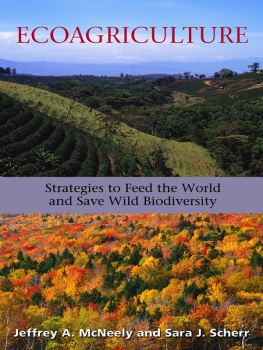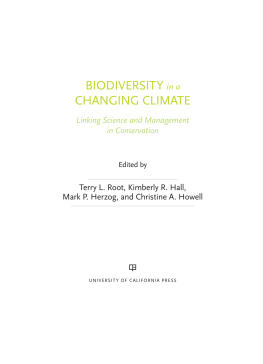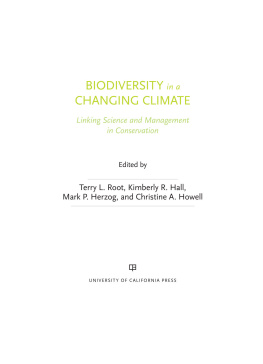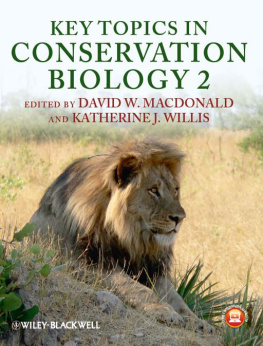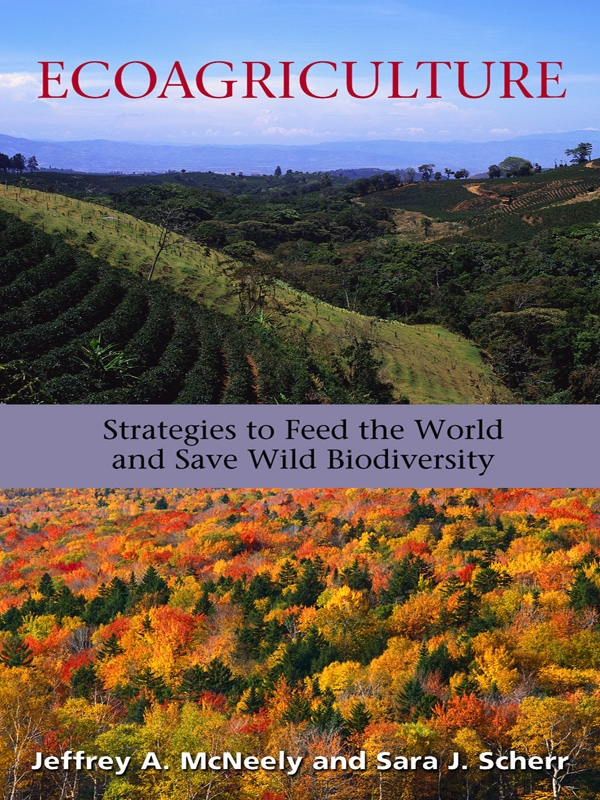Acknowledgments
The authors would like to express their appreciation to the many generous colleagues who contributed materials used in this book, including Brian Belcher, Steve Franzel, Naoya Furoda, Dennis Garrity, David Kaimowitz, Ted Lefroy, Erik Lichtenberg, Ruth Meinzen-Dick, Peter Neuenschwander, Michele Pena, Ruth Raymond, Colin Rees,Tom Simpson, and Stanley Wood. We benefited greatly from thoughtful comments provided by Weber Amaral, Lukas Brader, Gretchen Daily, Toby Hodgkin, Roger Leakey, Jules Pretty, Jeff Sayer, Meine van Noordjik, and three anonymous reviewers on earlier drafts. For sharing their perspectives on the current state of biodiversity-friendly agriculture, we thank Bruce Boggs, George Boody, Kate Clancy, Randy Curtis, Dana Jackson, Kathy MacKinnon, Gunnars Platais, Barbara Russmore, and all the members of the Katoomba Group, particularly Carl Binning and Ken Chomitz.
Barbara Rose, then the executive director of Future Harvest, provided the inspiration for this paper and valuable feedback all along the way. We drew heavily from materials produced by IUCN and all the Future Harvest Centers: CIAT, CIFOR, CIMMYT, CIP, ICARDA, ICLARM, ICRAF, ICRISAT, IFPRI, IITA, ILRI, IPGRI, IRRI, ISNAR, IWMI, and WARDA. Special thanks go to Kate Sebastian for preparing many of our maps. We also appreciate Population Action Internationals help in reproducing some of their maps from Natures Place (Cincotta and Engelman 2000). Thanks to Shannon Allen, Ben Dappen, Nathan Dappen, Sandra Gagnon, Joseph McNeely, Michael McNeely, Uday Mohan,Yolanda Palis, Arthur Rosenberg, and Jason Wettstein for their excellent assistance in research and manuscript preparation, and especially to Sue Rallo for her steadfast secretarial support at IUCN. We are grateful to our editors Todd Baldwin, James Nuzum, Cecilia Gonzlez, and Randy Baldini for their help in finalizing the manuscript for Island Press. Any errors that remain are ours alone.
Jeff thanks Pojanan Suyaphan McNeely for her kind suffering in silence while her husband was occupied in writing this book. Sara warmly thanks her husband, Alan Dappen, and sons, Ben and Nathan Dappen, for their encouraging support of her work on this project and for making sure she still took some time off to enjoy the biodiversity of Virginia.
About the Authors
Jeffrey McNeely worked in Asia for twelve years following his training in anthropology at the University of California at Los Angeles. He spent two years as a Peace Corps volunteer in southern Thailand, five years at the Association for Conservation of Wildlife in Bangkok, and two years studying the relationship between people and nature on the Tibetan border in the Himalayas of eastern Nepal. He spent three years in Indonesia as World Wildlife Fund-IUCN (World Conservation Union) representative, establishing IUCNs first country program and running some thirty-five conservation projects in that country. He joined IUCN proper in 1980, designing conservation programs, advising governments and conservation organizations on conservation policy and practice, and producing a variety of technical and popular publications. As Secretary-General of the IV World Congress on National Parks and Protected Areas (Caracas 1992), McNeely helped develop new concepts for relating people to protected areas. Formerly Director of IUCNs Biodiversity Programme and currently Chief Scientist, he has contributed to all of the major global biodiversity initiatives. He has advised over fifty governments on their biodiversity strategies and action plans and was a founder of the Global Biodiversity Forum. He has published numerous papers and over forty books, including Soul of the Tiger; Mammals of Thailand; Economics and Biological Diversity; Conserving the Worlds Biological Diversity; Partnerships for Conservation; Protecting Nature: Regional Reviews of Protected Areas; National Parks Conservation and Development; and The Great Reshuffling: Human Dimensions of Invasive Alien Species.
Sara J. Scherr is an agricultural and natural resource economist, specializing in tropical land and forest policy. While completing her B.A. in economics from Wellesley College, she studied deforestation in Costa Rica. A Fulbright Scholar, she received her M.Sc. and Ph.D. in international economics at Cornell University (1983), with theses on river basin development programs in Mexico and impacts of the oil boom on Mexican cocoa producers. At the Food Research Institute of Stanford University, she compared oil boom impacts on agriculture in Indonesia, Mexico, and Nigeria. She then joined the International Centre for Research in Agroforestry in Nairobi, Kenya, as a Rockefeller fellow and later Principal Researcher, developing methods for on-farm agroforestry research. In 1992, she joined the International Food Policy Research Institute in Washington, D.C., as a Research Fellow, where she led the Policies for Sustainable Intensification in Fragile Lands program, with field studies in the hillsides of Honduras and Ethiopia. She is presently Senior Policy Analyst of Forest Trends, and Advisor to the Future Harvest Foundation. She is also an adjunct professor at the Agricultural and Resource Economics Department of the University of Maryland, College Park. Her current research is on policies to promote ecosystem services in agricultural landscapes, forest markets for low-income producers, economic impacts of land degradation, and community watershed management. She has published over 100 papers and nine books, including Agriculture and the Oil Syndrome; Costs, Benefits, and Farmer Adoption of Agroforestry; Policy Research for Sustainable Development in Mesoamerican Hillsides; Pilot Assessment of Global Ecosystems: Agroecosystems; Response to Land Degradation; and Trees on the Farm: Assessing the Adoption Potential of Agroforestry Practices in Africa.
References
Abramovitz, J.N. 1996. Imperiled Waters, Impoverished Future: The Decline of Freshwater Ecosystems. Worldwatch Institute,Washington, D.C.
Adejuyigbe, C.O., G. Tian, and G.O. Adeoye. 1999. Soil microarthropod populations under natural and planted fallows in southwestern Nigeria. Agroforestry Systems 47 ( 13) :263272.
Agarwal, A., and N. Sunain. 1999. Community and Household Water Management: The Key to Environmental Regeneration and Poverty Alleviation. Poverty and Environment Issues Series No. 2. United Nations Development Programme and the European Commission, New York.
Ahmed, Mahfuzuddin, and Philip Hirsch, eds. 2000. Common Property in the Mekong: Issues of Sustainability and Subsistence. ICLARM Studies and Reviews 26. Penang, Malaysia: International Center for Living Aquatic Resources ManagementThe Fish Center and the Australian Mekong Resource Center.
Akhter, F. 2001. Agricultural biodiversity and the livelihood strategies of the very poor in rural Bangladesh. Paper presented to the International Symposium on Managing Biodiversity in Agricultural Ecosystems, 810 November, Montreal, Canada.
Alcorn, Janice B., ed. 1993. Papua New Guinea Conservation Needs Assessment. (2 vols.). Biodiversity Support Program, Washington, D.C.
Alexander, Richard B, Richard A. Smith, and Gregory E. Schwarz. 2000. Effect of stream channel size on the delivery of nitrogen to the Gulf of Mexico. Nature 403:758760.
Alfaro, Milena. 2000. Environmental and social factors: Organic Community Products Eco-Enterprises Fund, a Fund of The Nature Conservancy and partners, Washington, D.C. Unpublished memo.
Altieri, M.A. 2001. Agroecology: Principles and strategies. Overstory 95. Available at http://www.agroforester.com/overstory .

